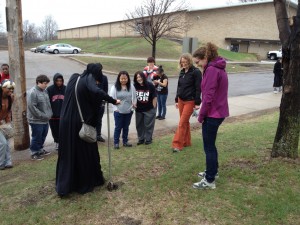This spring Seth Spawn and I, and another St. Olaf student named Kirsten Maier, created a partnership with two environmental science high school teachers at Harding High School in St. Paul. Our objectives were to bring Arctic science into the classroom and use it as a tool to teach about the carbon cycle and climate change as well as how scientific research is conducted. In addition, we were hoping to learn how to share our research with non-scientists, create meaningful dialogue, and get high schoolers excited about the Arctic. Harding High School is located in the East Side neighborhood of St. Paul. It’s a large school of over 2,000 students, whose demographic is very diverse. Many of the kids in the classes we worked with were there because they needed a science credit and their adviser told them they shouldn’t take chemistry or physics. Environmental science in Minnesota high schools is often seen as a less rigorous science by students and other faculty.
In our first visit to the classrooms we tried to dispel this myth. We introduced ourselves, talking about our backgrounds and research experiences. I grew up 1.5 miles from Harding and had the same demeaning view of environmental science when I was in high school. So I talked about how my views changed when I learned in college how environmental science is extremely interdisciplinary. To do good environmental science you have to know chemistry, biology, and geology to name a few, and in my opinion the ecosystems we are trying study are far more complex than the systems an organic chemist might research, for example. We also introduced the Polaris Project on our first visit and had a question and answer session that ranged from questions about climate change to college life.
Our second classroom visit we gave a lecture about climate change and the carbon cycle. We had them construct a carbon cycle for us, and then showed them how the carbon cycle is different in the Arctic and what this means for climate change. Our third visit we took them soil sampling and worked on a small research project with them. Together we took soil samples from around Harding and from urban forest sites they picked out. We also took soil cores from a prairie, corn field, and forest preservation near St. Olaf. The class made predictions about how soil carbon compared between land-use types and we helped them with the data analysis to see if they were correct. (The preserved forest had twice as much soil carbon as every other site).
This collaboration was extremely rewarding for both us and the teachers we worked with. The students were incredible and exceeded their teachers’ expectations. They were very engaging, asked in depth questions, and were excited about doing research. The days we came to the classroom had some of the best attendance all year. It was inspiring for us to see how excited the students got about Arctic science, and our collaborating teachers expressed rejuvenated passion for teaching.




